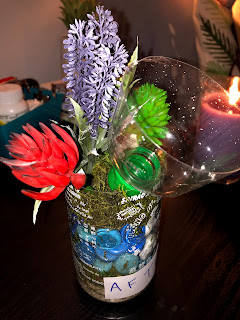TEDTalk | Stephanie Buxhoeveden | "Thriving in the Face of Adversity"
I chose to watch a TEDTalk called “Thriving in the Face of
Adversity” by Stephanie Buxhoeveden. TEDTalks provide not only a personal and
humanizing, but also educational, an account of what someone has experienced and/or
accomplished. Because Stephanie was studying to be a nurse, she was able to
drive home her message from both of the aforementioned standpoints, and it
resonated well with me as a current OT student and future practitioner. Learning
relevant material from textbooks or lectures is not sufficient. As an OT, real-life
exposure to others and their conditions is important so that through
familiarity we can work more adaptably and efficiently. By listening/watching
others’ personal accounts, we can deepen our capacity for empathy and use it
throughout our practice.
MS initially presented itself as a chronic numbness in
Stephanie’s foot and gradually spread upward in both of her legs. Stephanie
experienced her first concerning signs of Multiple Sclerosis (MS) the very
first time she was going to administer anesthesia as a student. As she was dressing, she realized she was completely numb from the waist down, lost all
feeling in her right arm, lost the ability to move her right hand, and her
vision became very blurry. Stephanie was diagnosed in the ER after a spinal
tap, IV infusions, and several MRIs. During this TEDTalk, Stephanie gave a good
explanation of MS in layman’s terms so that her audience could understand. MS
is a disease that attacks the myelin covering on nerves in the brain and spinal
cord, affecting neuronal communication. There is currently no cure, but her
symptoms of numbness, tingling, paralysis, and loss of vision can be treated.
The onset of MS is most common in young adults such as
Stephanie. As a young student like Stephanie was, wondering how MS would impact
my life at this very moment is unimaginable. Stephanie was a successful student
and participated in heavy resistance training for leisure. Now during her
relapses, she needs a cane to walk, has to take medication for nerve pain,
experiences numbness, and tingling, and undergoes intensive treatment. One day
when she went to the doctor as a patient, she was able to educate the nursing
student who tended to her. From this, a seed was planted. Shortly after, she
received a recommendation from her doctor to change careers. Stephanie took
this as an opportunity to change others’ lives and decided to become an expert
in MS.
A combination of personal experience and professional
expertise gave her an advantageous ability to have a positive impact on the
lives of others. She became a board-certified MS nurse and changed her career
path to that of a nurse practitioner. She (perhaps unknowingly) acknowledges
and understands the holistic approach that OT’s use. Not every healthcare
provider has the time or knowledge to educate every patient on everything that
has to do with their specific diagnosis, and many clients do not have the
assistance of specialists either. While we may not specialize in MS, it is up
to OT’s to dedicate our time to our clients so they can have that special physical
and emotional attention that other professions fail to give. Stephanie also indirectly
advocated for independence by creating a website that is user-friendly so that
those with MS may be an active participant in their own care without the
need of a specialist. The website provided an understanding to others who may
have had the disease for decades and can finally understand their bodies. It is
not a cure, but it has made a profound impact on empowering others. Stephanie’s
diagnosis of MS was not the end of her life. Rather, it was a new beginning as
it made her a better nurse, a better purpose, and gifted her with a purposeful
life.
~ Pam ♡
TEDx Talks. (2015, April). Thriving in the Face of Adversity [Video file]. Retrieved from https://www.youtube.com/watch?v=zuLOT6GsAxw




